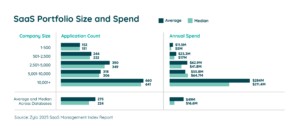Table of Contents
When it comes to driving business growth, SaaS can be an incredibly powerful tool. It’s easy to purchase, fast to implement and often cheaper than on-premise solutions.
Yet, it’s these very same benefits that can actually make holistically managing your SaaS portfolio difficult. Without effective SaaS subscription management, it’s easy for IT teams to quickly lose track of SaaS costs, security and access.
In this article, we’ll explore why subscription management should be a priority, four specific steps you can take to get SaaS under control — and, finally, why you don’t have to go it alone.
Why Organizations Must Make SaaS Subscription Management a Priority
Let’s start off with a question. How many SaaS applications do you have within your organization?
Now that you have your number – is that based on a database you’re using to track SaaS applications – or is it just your best guess?
How many applications do you think the average organization had in 2024? How much did they spend?
The average company had 275 apps and spent $49M. (More than you expected, huh? It’s more than we expected, too.)

Don’t feel bad — most organizations consistently underestimate how many SaaS applications they have by nearly 2X and spend by 3X. When it comes to SaaS, perception often doesn’t align with reality.
But why is SaaS so grossly underestimated?
It’s because of one inherent quality that nearly all SaaS tools have: product-led growth, which is a growth model that focuses on end-users. Instead of getting sourced by IT and then distributed to relevant teams or the entire organization, most SaaS applications start in an org with just a handful of licenses. The impact (and the cost) grows from there — it’s why go-to-market teams call it “land and expand.” (With the freemium model, sometimes all it takes is one license).
In a phrase: most purchased applications don’t go through a formal vetting and procurement process. Instead, they’re acquired by business units, teams and individuals — often via expense.
Take a look at the difference between applications managed by business units and employees compared to those managed directly by IT.
Those applications purchased without the knowledge of IT is what we call shadow IT — and it creates unnecessary costs and risk for organizations.
But what’s the solution? Establishing a process for effective SaaS subscription management.
What’s New in 2025?
Stacks are larger, renewals are more frequent, and optimization is now a board-level issue. Leaders are prioritizing visibility, license usage, and renewal monitoring.
According to our data, organizations on average have 275 subscriptions and spend $49M annually, yet use only 47% of their licenses, which equates to about $21 million in wasted spend per organization.
Renewal volume is still climbing, with 247 renewals per year on average and 85% of the total software spend tied to renewals.
Three trends stand out in 2025:
- Optimization is moving from ad hoc to always-on. Teams have started standardizing continuous license monitoring, duplicate tool consolidation, and reducing redundancy.
- Legal, procurement, finance, and application owners are working from shared renewal timelines to avoid surprise auto-renewals and to develop data-informed negotiations.
- SaaS Management Platforms are applying machine learning to find inactive licenses, overlapping functionality, and contract risks faster than manual review.
How to Manage SaaS Subscriptions Effectively
We’ll give it to you straight: it’s time to make SaaS subscription management a priority. It doesn’t have to be overwhelming. Follow these steps:
- Discover what applications you have
- Build relationships with application purchasers
- Identify ways to save money
- Get proactive for the future
Step 1: Discover What You Have
You can’t effectively manage SaaS subscriptions if you don’t even know what you have. And our data shows that companies underestimate the number of applications in their stack by nearly twofold. Centralize all of your subscriptions into a single system of record, including:
- Who has a license
- The renewal date
- How much it costs
- Contract details
The first step is to get full visibility into every application used by your organization, their associated costs, and which team or employee has purchased them. Leading companies use a SaaS Management Platform (SMP) to discover and inventory their subscriptions, using sources like AP and expense reports and single sign-on. Without continuous discovery, it’s practically impossible to maintain any sort of accurate inventory.
Once you have a complete picture of all of the SaaS applications in use at your organization, document all key contract details in a single system of record. This record will serve as the single source of truth for all SaaS actions and decisions that’s updated in real-time.
Step 2: Build Relationships with Application Purchasers
Shadow IT makes up nearly half of all software purchases. As such, IT and procurement pros often find themselves at odds with the employees and teams that purchased the tools.
But it doesn’t have to be that way. Collaboration is key to effective SaaS Management, so take the time to invest in that relationship between IT and application owners across the business.
Start by making it a priority to build relationships with the people who own vendor relationships in your organization – and keep the lines of communication open at all times. Doing so will increase visibility, security, and value for everyone involved.
It will also support your efforts downstream, as you gain a better understanding of how teams and individual employees are using (or not using) specific SaaS tools.
Step 3: Identify Ways to Save Money
SaaS is easy to acquire, making it easy for SaaS costs to get out of control. Our data shows that the average company wastes $21M annually just in unused licenses. SaaS optimization strategies that can help you cut costs and risk include:
- Rightsize: Take stock of who is actively using a SaaS subscription, and who can be taken off.
- Consolidate: Ensure multiple teams within the organization aren’t using the same tool on different contracts.
- Reduce Redundancy: Identify the tools that have the same functionality, make an informed decision for which to keep and which to opt out of.
Step 4: Proactively Manage SaaS Renewals
With hundreds of renewals at the average company each year, it’s challenging for Procurement teams to keep up. Proactive renewal management practices ensures:
- Renewals are not missed and don’t auto renew
- Proper planning and prioritization of renewals
- Time to rightsize licensing, benchmark pricing, and negotiate with vendors
Surprise renewals are risky because they lead to hasty—and often expensive—renewal decisions. The first step is to more proactive renewal management is to develop a renewal calendar. This provides visibility into timelines and alerts you when renewal dates and negotiation periods are approaching. That way, you’ll have plenty of time to gather the information you need and you’ll be better equipped to collaborate with the right application purchaser to make smart, data-based renewal decisions.
Strategies for Managing Software Subscriptions
Top strategies for managing software subscriptions include:
- Regular software audits
- Billing and renewal automation
- Implementing role-based access
- Integrating SaaS Management with finance and IT systems
- Software policies training for employees
Regular Software Audits
Develop a quarterly audit cycle that checks inventory accuracy, owner assignments, license usage, and renewal dates against both finance and SSO records.
For consistency, use a repeatable checklist that covers contract terms, notice periods, cancellation rules, data residency, compliance demands, and future integrations.
Add a simple business value review for various applications to determine whether an app is still needed, can be dropped to a lower tier, or eliminated entirely.
Audits can be more actionable by flagging licenses that have gone unused for 90+ days and reviewing top-spend applications against organizational priorities. Benchmarking usage and costs against industry standards helps to highlight opportunities to negotiate contracts or consolidate tools.
Billing and Renewal Automation
Create calendar entries with contract terms and notice windows on Day 1, not just before the renewal date. Direct purchase and renewal requests through a centralized intake with specific fields for business case, data handling, and owner assignment. Integrate with finance systems to validate invoices and flag price changes, excess true-ups, or unexpected add-ons.
Implementing Role-based Access
Adopt role-based access control to reduce unnecessary licenses and permissions. Provision by group through your identity provider, and tie group memberships to job role and employment status. Deprovision access automatically once roles change or offboarding occurs, and schedule regular recertifications for sensitive tools. Right-sizing often leads to reductions in paid seats and improves security at the same time.
Integrating SaaS Management with Finance and IT Systems
Connect your SaaS Management Platform to SSO, HRIS, ERP, and ticketing. SSO and HRIS improve discovery, license assignment, and offboarding. ERP integration centralizes contract data and general ledger details, which makes variance analysis and forecasting easier.
Ticketing integration organizes intake for purchases and access changes to improve auditability. Security and compliance teams are beneficial as well, being that unified inventory tends to speed up risk assessments and vendor reviews.
To further enhance efficiency, organizations can set automated reminders for upcoming renewals or license reviews. Tracking usage trends alongside contract terms also allows teams to make proactive adjustments to subscription tiers. Further, role-specific dashboards help stakeholders identify redundant applications or underused licenses, and continuous monitoring ensures that optimization opportunities are not missed.
Software Policies Training for Employees
Offer employees short, role-specific training opportunities that explain relevant categories, how to request a new tool, why license reassignment matters, and what to do when a vendor contacts an employee directly.
It’s also wise to publish a catalog of approved applications with benefits and request links, then reinforce these efforts with quarterly micro-lessons and management talking points.
Current and Future Strategies in SaaS Subscription Management
Several trends are shaping how organizations manage SaaS subscriptions effectively:
- Usage telemetry informs negotiations.
- Security and compliance remain a priority
- Subscription management will become cross-departmental.
- Predictive tools will prevent unnecessary costs.
- Shared dashboards will support team decision making.
- Organizations will aim to minimize software sprawl.
Usage telemetry will likely play a more important role in vendor negotiations, as buyers present activity-based data that supports cost reductions. Security and compliance will continue to be a key factor in driving renewal decisions and speeding up “stay or go” calls when vendors fail to meet standards.
It’s also likely organizations will start treating subscription management as a shared responsibility, spread across department leaders in finance, IT, and security.
Organizations will utilize AI-powered analytics to monitor licenses and predict trends, which will help reduce underutilized subscriptions before they generate unnecessary costs.
Cross-department collaboration will continue to grow as well, with IT, finance, security, and procurement teams using shared dashboards for strategic decision-making. Finally, sustainability will become a key consideration, as companies aim to minimize software sprawl.
Don’t Go It Alone: Use SaaS Subscription Management Software
Manual, spreadsheet-based tracking can’t keep up with growing SaaS portfolios. Partnering with a SaaS Management provider simplifies discovery, cost control, and risk mitigation while ensuring employees still have access to the tools they need. With application use only continuing to grow, it’s time to adopt a more effective approach.
A dedicated platform collects and organizes data from multiple sources, correlates it in real time, and applies AI to spot unused licenses, high-risk vendors, and pending renewals before the due date passes.
Look for a provider that provides solutions around:
- Discovery and inventory
- License management
- Renewal management
- Risk mitigation and compliance
Discovery and Inventory
Department leaders need to look for continuous discovery from multiple data sources, including expense, SSO, finance, and direct vendor connections. Being well-informed makes finding new tools that much easier and quicker to find. Make sure the platform supports owner assignment, tagging, and configurable fields for data types, contracts, and risks.
License Management
Collect and review data on seat-level visibility, usage insights, and automated reclamation workflows so that you can reassign before buying more. Focus on features that pinpoint inactive users, underused premium tiers, and opportunities to move to lower cost plans.
Renewal Management
To proactively manage renewals, a SaaS subscription management platform should provide a centralized renewal calendar, spend insights, and automated alerts aligned to renewal milestones. From there, attach usage trends, legal terms, and benchmark information to each renewal record. This is a must when businesses typically face around 247 renewals each year and spend around 85% of their SaaS budgets on renewals.
Risk Mitigation and Compliance
Centralize risk details for each vendor and include information like security certifications, data residency, DPA status, and privacy terms. Tie each of these details directly to the renewal process so that decision making factors in risk in addition to cost. Automating intake questionnaires and periodic security reviews is also a considerable option.
Maximizing the Value of Your Software with Zylo
If you are ready to move from manual spreadsheets to always-on SaaS Management, start by scheduling a demo to see how Zylo can help with discovery, license optimization, spend control, renewals, and governance.
FAQs About Managing Software Subscriptions
ABOUT THE AUTHOR

Zylo
Zylo is the leading enterprise SaaS management platform that transforms how companies manage and optimize the vast and accelerating number of cloud-based applications organizations rely on today. The platform provides one system of record for all cloud-based software purchased across a company, enabling customers to discover, manage, measure and optimize cloud investments with real-time insights into spend, utilization and feedback data.

